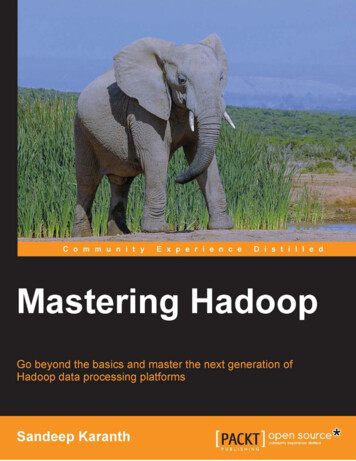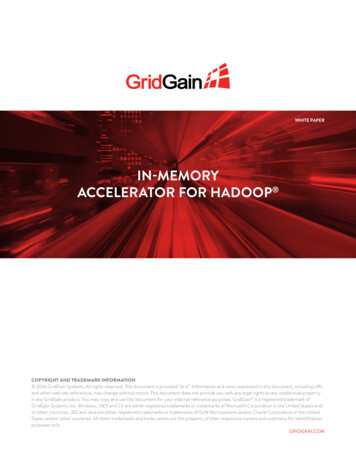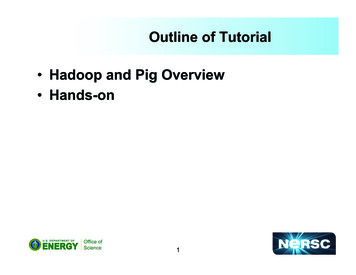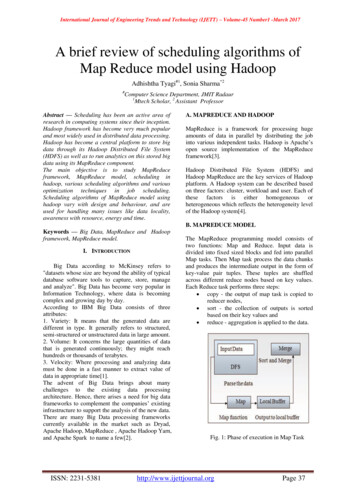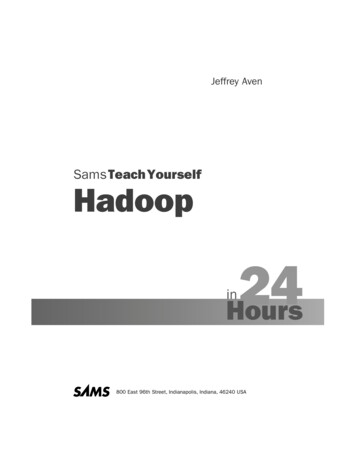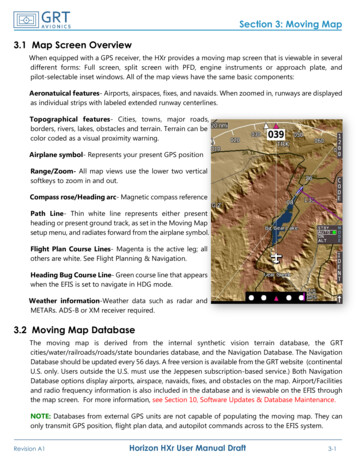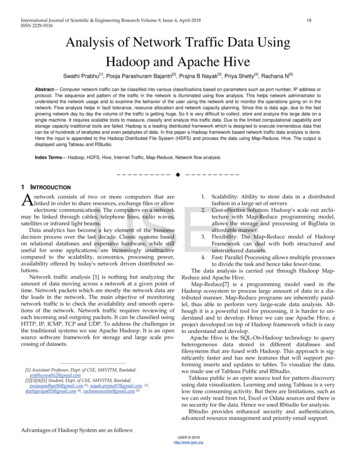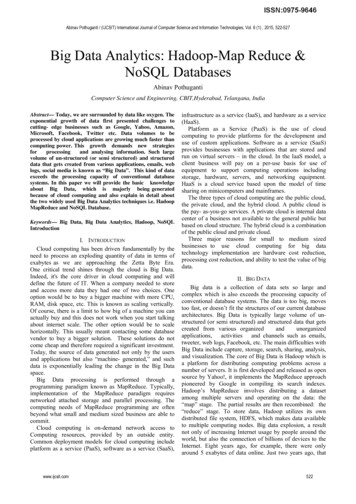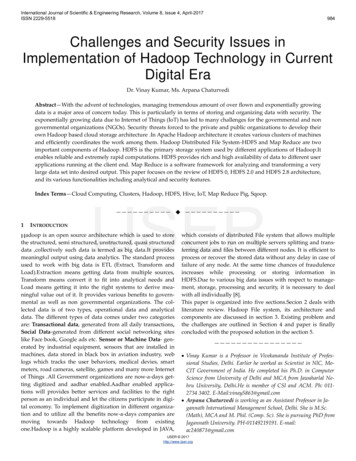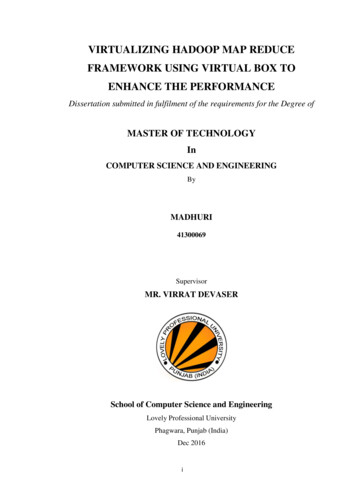
Transcription
VIRTUALIZING HADOOP MAP REDUCEFRAMEWORK USING VIRTUAL BOX TOENHANCE THE PERFORMANCEDissertation submitted in fulfilment of the requirements for the Degree ofMASTER OF TECHNOLOGYInCOMPUTER SCIENCE AND ENGINEERINGByMADHURI41300069SupervisorMR. VIRRAT DEVASERSchool of Computer Science and EngineeringLovely Professional UniversityPhagwara, Punjab (India)Dec 2016i
ii
ABSTRACTHadoop Distributed File System is used for storage along with a programmingframework MapReduce for processing large datasets allowing parallel processing. Theprocess of handling such complex and vast data and maintaining the performanceparameters up to certain level is a difficult task. The paper works towards an approach ofimproving the performance by virtualizing the Hadoop framework using virtual box. Thiscan be demonstrated by establishing virtual machines for the slave nodes in the physicalmachine where the master node also resides. The configuration of Hadoop virtual cluster isimplemented to achieve high performance.iii
DECLARATION STATEMENTI hereby declare that the research work reported in the dissertation entitled“Virtualizing Hadoop Map Reduce Framework Using Virtual Box To Enhance ThePerformance” in partial fulfillment of the requirement for the award of Degree forMaster of Technology in Computer Science and Engineering at Lovely ProfessionalUniversity, Phagwara, Punjab is an authentic work carried out under supervision of myresearch supervisor Mr. Virrat Devaser I have not submitted this work elsewhere forany degree or diploma.I understand that the work presented herewith is in direct compliance withLovely Professional University’s Policy on plagiarism, intellectual property rights, andhighest standards of moral and ethical conduct. Therefore, to the best of my knowledge,the content of this dissertation represents authentic and honest research effortconducted, in its entirety, by me. I am fully responsible for the contents of mydissertation work.Signature of CandidateMadhuri41300069iv
SUPERVISOR’S CERTIFICATEThis is to certify that the work reported in the M.Tech Dissertation entitled“Virtualizing Hadoop MapReduce Framework Using Virtual Box To EnhanceThe Performance”, submitted by Madhuri at Lovely Professional University,Phagwara, India is a bonafide record of his / her original work carried out under mysupervision. This work has not been submitted elsewhere for any other degree.Signature of SupervisorMr.Virrat DevaserDate:Counter Signed by:1)HoD’s Signature:HoD Name:Date:2)Neutral Examiners:(i)Examiner 1Signature:Name:Date:(ii)Examiner 2Signature:Name:Date:v
ACKNOWLEDGEMENTI would like to take this noble opportunity to extend my deep-sense of gratitudeto all who helped me a lot directly or indirectly during the development of thisdissertation proposal.Fore-mostly I want to express wholehearted thank to my mentor, Mr. Virrat Devaserfor being such a worthy mentor and best ever adviser. His precious advice, motivationand critics proved the sources of innovative ideology, encouragement and main causebehind the successful completion of this dissertation. I am very much obliged to all thelecturers of computer science and engineering dept. for their heartfelt encouragementand support.I also extend my sincerest thanks and gratitude towards all mates for theirconsistent support and invaluable suggestions provided at that time when I required themost. I am very grateful to my lovable family for their support, love and prayers.Madhurivi
TABLE OF CONTENTSCONTENTSPAGE NO.Inner first pageiPAC formiiAbstractiiiDeclaration by the ScholarivSupervisor’s CertificatevAcknowledgementviTable of ContentsviiList of AbbreviationsixList of FiguresxList of TablesxiCHAPTER 1: INTRODUCTION11.1Big Data11.1.1 Three V’s of Big Data1Hadoop21.2.1 Why Hadoop21.2.2 HDFS51.2.3 MapReduce7Virtualization91.3.1 Types of Virtualization101.3.2 Benefits of Virtualization111.3.3 Various Platforms for Virtualization121.21.3CHAPTER 2: REVIEW OF LITERATURE13CHAPTER 3: PRESENT WORK18vii
3.1Scope of the Study183.2Objective of the Study193.3Research Methodology193.3.1Sources of Data203.3.2Research Design20CHPTER 4: RESULTS AND DISCUSSION214.1Configuration of Hadoop214.2Creating Hadoop Cluster234.3Performance254.3.1Performance of Hadoop in Virtual Cluster254.3.2Performance with Physical Machine294.3.3Performance Metrics of Cluster32CHAPTER 5: CONCLUSION AND FUTURE SCOPEREFERENCESviii34
LIST OF ABBREVIATIONAPIApplication Programming InterfacesBYODBring Your Own DeviceETLExtract Transforms LoadHDFSHadoop Distributed File SystemOSOperating systemVCCVirtual Client ComputingVMMVirtual Machine MonitorsVMVirtual Machineix
LIST OF FIGURESFIGURE NO.FIGURE DESCRIPTIONPAGE NO.1.1Three Vs of Big Data11.2Architecture of Hadoop System31.3HDFS Architecture61.4Job and Task Tracker91.5Virtual Machine Monitors103.1Research Design204.1Hadoop Performance for DataSet 1 - I264.2Hadoop Performance for DataSet 1 – II264.3Hadoop Performance for DataSet 1 - III274.4Hadoop Performance for DataSet 2 - I274.5Hadoop Performance for DataSet 2 – II284.6Hadoop Performance for DataSet 3 - I284.7Performance for DataSet 1 - I294.8Performance for DataSet 1 - II294.9Performance for DataSet 2 - I304.10Performance for DataSet 2 - II304.11Performance for DataSet 3 - I314.12Performance for DataSet 3 – II314.13Time Comparision between Real and Virtual Clustersfor WordCount Operation324.14Time Comparision between Real and Virtual Clustersfor Average Operation33x
LIST OF TABLESTABLE NO.TABLE DESCRIPTIONPAGE NO.Table 1Time Taken by Physical and Virtual Cluster toPerform WordCount32Table 2Time Taken by Physical and Virtual Cluster toPerform Average33xi
Checklist for Dissertation-II SupervisorName: UID: Domain:Registration No: Name of student:Title of Dissertation: Front pages are as per the format. Topic on the PAC form and title page are same. Front page numbers are in roman and for report, it is like 1, 2, 3 . TOC, List of Figures, etc. are matching with the actual page numbers in thereport. Font, Font Size, Margins, line Spacing, Alignment, etc. are as per theguidelines. Color prints are used for images and implementation snapshots. Captions and citations are provided for all the figures, tables etc. and arenumbered and center aligned. All the equations used in the report are numbered. Citations are provided for all the references. Objectives are clearly defined. Minimum total number of pages of report is 50. Minimum references in report are 30.Here by, I declare that I had verified the above mentioned points in the finaldissertation report.Signature of Supervisor with UIDxii
CHAPTER 1INTRODUCTION1.1 Big DataEvery single minute, Facebook users share nearly 2.5 million of data. Twitterusers post tweet nearly 300,000 times. Users of Instagram post new pictures nearlyabout 220,000 .YouTube users upload 72 hours of new videos. Email users send over200 million mails. Amazon generates over 80,000 in online shopping and Googlereceives queries about 4 billion from global users of around 2.4 billion [17]. So this ishow data is increasing, referred to as ―Data Tsunami. Such huge datasets and richmix of data type and format is commonly known as ―Big Data. This data is so vastand complex that it is beyond the scope of any traditional data processing applicationto handle this kind of data within a tolerable elapsed time. Hadoop came as a solutionto this problem and helped to extract, transform, analyse and store this big data.Fig1.1: 3-Vs of Big Data1.1.1Three Vs of Big DataAs shown in Fig 1.1, Big Data is about three different VsVolume1
Data storage is growing exponentially because now a days data is not only about textonly, it consists of videos, music and large images on our social media channels. It isvery common to have Terabytes and Petabytes of the storage system for enterprises.VelocityThere is tremendous growth in data. Data explosion has changed how we look at thedata. There was a time when we used to believe that data of yesterday is recent. Thereis lot of data movement and updates are within fractions of the seconds. This highvelocity data represent Big Data.VarietyMultiple formats are available to store data e.g. database, excel, csv, access or for thematter of the fact, it can be stored in a simple text file. The real world have data inmany different formats.1.2 HADOOPHadoop is a popular, open source, java based software framework that provides aplatform for distributed processing and analysis of large datasets across clusters ofcomputers.It is used for scalable, fault tolerant,flexible,reliable and distributedcomputing. Hadoop was derived from Google‘s MapReduce, a distributed system andGoogle File System (GFS), a distributed file system. Hadoop can increases theprocessing power and the storage by combining many computers into one.Architecture of Hadoop system is shown in Fig 1.2. The main component ofHadoop includes: Hadoop Distributed File System (HDFS) Map-Reduce1.2.1 Why HADOOPHadoop enables big data applications for both analytics and operations.Hadoop is one of the popular, fastest growing technologies and a key component ofthe next generation data architecture which provide a great processing platform andscalable distributed storage as well. The advantages of using Hadoop framework areas follows.2
Fig 1.2: Architecture of Hadoop System1. Low Cost: Hadoop is a freely available, open source framework so there is nocost required to get this software. On the other hand, the large datasets andinformation will be stored by having minimal hardware requirement.2. Flexibility of data: Hadoop can handle different variety of data i.e. structured,semi structured or unstructured and also the compatible with the differentresources from where the data is coming. The increasing data from socialmedia and networked devices is the key consideration.3. Processing Speed : Hadoop is mainly used for processing large amount ofdata as its computation power is very high because the map and reduce jobsare executed on various data chunks of different virtual machine at a timewhich will automatically reduce the computation time and increase theprocessing power.4. Scalability: Hadoop is highly scalable system. As the data in organizationincreases it can handle that by adding large numbers of nodes with the leastoverhead being a distributed approach.5. Failure Tolerant: Hadoop stores huge data across the various machines indistributed system. Multiple (generally three) copies of that data is stored forhigh availability and when any node goes down, the same data will berecovered from another node providing the protection against fault.6. Fast access: Hadoop is able to handle large amount of unstructured dataefficiently using MapReduce jobs with HDFS in very economical time limit.Hadoop framework also has some limitations which are as follows3
1. Suitability for small data: Hadoop framework is not suitable for smalldatasets. As this platform is compatible and designed for large amount of dataso it is not efficient to use it for the organizations having small quantity ofdata.2. Security issues:Hadoop‘s security is the main challenge. Because it is the keycomponent for any organization to keep the data safe. In Hadoop encryption ismissing at storage and network levels. Although steps are taken towardsenhancing the security of Hadoop framework, using Kerberos authenticationtechnique is one of them.3. Skill gap: It is easy to search programmer who are comfortable in SQLprogramming than to MapReduce programming skills.4. Frequent data change: Hadoop is not suitable for the system where frequentdata changes occur so where the basic RDBMS operations like data insertion,deletion and updation is required for frequent changes in data processing,Hadoop is less efficient.The Apache Hadoop open source software library is a framework which is usedfor its distributed processing of massive data sets across clusters of computers .asingle server is multiplied to many numbers of machines providing local storagecapacity and processing of data. It provides high scalability, reliability anddistributing computation of data. Hadoop main module includes: Common: It is the also termed as Hadoop core as it provides the basic andessential services to all the other modules in the framework. HDFS: It is the java based distribution file system that holds very hugeamount of data and offers easy access to that data. MapReduce: It is the data processing technique and programming model fordistributed computing.Other projects related to Hadoop are as follows:1. Avro : A project used for data serialization2. Cassandra: It is a scalable database used for online web and mobileapplications with no single point of failure.3. Hbase: It is a NoSql, distributed database which provides big tablescapabilities of Hadoop.4
4. Chukwa: It is a system for data collection used for managing in largedistributed systems.5. Hive : It is a data warehouse infrastructure used for querying and analysis oflarge datasets6. Mahout: It is an open source machine learning library to provide distributedanalytics capabilities.7. Pig: It provides engine for data flow in parallel.As discussed earlier, Hadoop has two main components1. HDFS (Hadoop Distributed File System)2. MapReduce1.2.2 HDFSThe Hadoop Distributed File System is a scalable and reliable file system thatis suitable for distributed storage of data. HDFS is highly cost efficient as it isdeveloped on low cost hardware and is fault tolerant. It can store a very huge amountof data and provide the streaming access to that data .The files of such large data willbe distributed across various machines and stored redundantly as blocks in the system.HDFS ArchitectureHDFS is a master – slave architecture containing two nodes as shown in Fig 1.31. Name Node (As single master node)2 .Data node (As Multiple slave nodes)Name Node: It stores the metadata of the file system. It manage the namespace andallows the client to directly access to the files. Name node performs namespaceoperations i.e. Opening, renaming and closing of files and directories.Data Node: It stores the actual data. Each cluster will have several data node toperform the task assigned by the Name node. Data node performs block operationssuch as create, delete and replicate as directed by name node. It will provide service tothe read and write request of client.HDFS exposes the namespace of a file system and then stores that user datainto files. The file thus created will be divided into multiple blocks (normally block5
size is of 64 Mb). Then the replication of blocks is processed and each block isassigned to data node.As the name node maintain the metadata for every file, in its main memory.The mapping between the name of files stored, blocks and their data nodes will bedetermined. So that the any request of client to perform any action will pass throughName node and then name node directs the appropriate data node to perform the task.Client can interact with the data node directly to process the request and performoperations on the file system.7Fig 1.3 HDFS ArchitectureRelationship Status Between Name Node and Data NodeThe status of connectivity between Name node and Data node can be trackedusing Heartbeat Mechanism. Heartbeat is a signal indicating that whether the datanode is alive or not. It carries information about storage capacity, used space infractions and number of data transfer currently occurring etc. In Heartbeat mechanismthe Name node assign task to the data node. In response Data node sends heartbeatsignal or message to the Name node confirming that it is in active condition. But incase when the Name not do not receive any heartbeat message from data node then it6
will mark it as a dead Data node and did not assign any task to that node in future andremoves it from the cluster.The same mechanism also takes place in job tracker andTask tracker.Various Characteristics of HDFS Huge Data sets: HDFS will run application having large amount of datasets.This dataset will typically ranges from gigabytes to petabytes in size. The datais stored within distributed machines and commodity hardware. Reliability: The main goal of HDFS is to provide reliability of storage data. Sothat any machine failure can occur but data will be still available for use.Failure can be detected using the heartbeat signals. Data Coherency: It follows the write once Read many model which providessimple coherence of data and gives high throughput access. Rebalancing of blocks: HDFS creates many replicas (typically 3) of datanodes and place it to the appropriate data nodes. It re-balance the data block ineach data node considering the space requirement i.e. data block is moved toanother data node for balancing the load or by creating the replicas of datablock for space utilization in data node. So it provides fault tolerance and highthroughput access to the data. Data integrity: The data integrity is carried at block level. The client computesthe checksum along with data and compares it with the correspondingchecksum. If it does not matches than that blocks is removed and data isfetched from its replica.1.2.3 MapReduceMapReduce is a processing model and scalable framework used for processinglarge amount of datasets in parallel on multiple nodes. It follows the divide andconquer technique for processing data. The main components of MapReducecomprise of Map stage and reduce stage .In which map function will map and processone pair of dataset to another in form of tuple (key/value pair) and the reduce functionwill take the output of map function as input and merge all the intermediate tuplesinto smaller tuples using corresponding key value and hence reduce the dataset.7
Map Stage: Map performs the function of data collection and processing. The inputtaken will be divided into smaller chunks.Map ( ) function:Input ----------- Output(k1, v1)------- List (k2, v2)Reduce Stage: Reduce function will take the output of map function i.e. theintermediate values as input and combines them to give a final output as a reduceddataset.Reduce ( ) function:Input ----------- Output(k2, List (k3,v2)------- list(k3,v3)Shuffling is also a step in MapReduce framework which is used to transfer the datafrom mappers to reducers.MapReduce consists two components1. Job Tracker ( A central component)2. Task Tracker (Distributed Component)Job Tracker: Job tracker is a master that is responsible for the scheduling andprocessing of all the jobs. Whenever a job is received by job tracker ,it will assign thatjob to the task tracker and coordinates the execution process of the job. It is run onMaster node i.e. Name node.Task Tracker: A task tracker will be assigned to perform map and reduce functionsfor the particular job by job tracker. It will give report to the job tracker about theprogress of the assigned task. Each task tracker has various number of slots (map andreduce function) which is required to perform a task. The balance of map to reducetask is also an important consideration which is managed by JVM. The Task trackerrun on slave node i.e. Data node.In Fig 1.4 the whole function of job tracker and task tracker is shown. The jobtracker will assign job to task tracker submitted by a user and that job is processed intask tracker. The Task tracker will update the job Tracker with current status8
Fig 1.4: Job and Task Tracker1.3 VirtualizationVirtualization is a concept of dividing the resource of the same hardware tomultiple operating system (same or different) and applications at same time,achieving higher efficiency and resource utilization. In this the two isolated operatingsystem can run simultaneously. Virtualization has proven as an effective tool for ITindustry as it increases its agility, scalability, flexibility and performance ratio. It istransforming the way to utilize techniques and resources. Hypervisor or virtualmachine monitor is the manager who carries out the process of virtualization asshown in Fig 1.51. Bare metal or Native2. Hosted Hypervisor.Bare metal hypervisor run directly on top of hardware to have more control poweroverhardware.Hosted hypervisor run on the top of conventional operating system along with somenative processes. It will differentiate the guest and host operating system running onthe single hardware.9
Fig 1.5: Virtual Machine Monitors1.3.1 Types of VirtualizationVirtualization can be utilized in different areas to enhance performance andresource sharing. So various types of virtualizations are as followingServer Virtualization: Server virtualization is a process in which multiple OS andapplications run on a single server so that resources of that single host will be dividedamong all the operating system and the various applications. It brings the resourceutilization and the cuts the cost by having only one server in place of many.Application Virtualization: Application virtualization enables the end user to accessthe application from remotely located server. Application is not installed on everyuser desktop but is available on user‘s demand. So it is very cost efficient for theorganizations.Desktop Virtualization: It is similar to server virtualization. In desktop virtualizationthe workstation with all its application is virtualized. The hypervisor contain thecustomization anf preferences of an application. It runs on a centralized mechanism souser can access the desktop from any location .It provides higher efficiency and thecost reduction.Storage Virtualization: Storage virtualization is a technique in which the storagefrom the multiple hardware devices will be combined to act as a single storage device.In this the storage space by SAN and NAS is virtualized along with the disk file ofvirtual machine. So it provides the disaster recovery management by replication.Network Virtualization: Network virtualization is a concept in which the all thenetwork from different network devices are combined into a single network called as10
a virtual network so that its bandwidth will be divided to channels which will be givento the server or device.1.3.2 Benefits of Virtualization Server Consolidation: In this existing application will be moved to the someservers. As it is one time event, it will reduce the cost and increase the spaceutility. Cost Reduction: Virtualization is very appropriate in cutting cost of theorganizations. As many servers are combined into one. The only single serverwill provide the same functionality to the user. Hence the cost of extrahardware, storage and maintenance overhead will be reduced to a greaterextent which saves both time and money. High Availability: The feature of high availability of virtual machine isprovided so that in case on any kind of failure of a particular virtual machinethe host will provide its replication from another virtual machine. It willautomatically reduce the downtime and cut the cost. Security: As centralized management is available, there is very less chance todata loss. It also provides control over interrupts and device DMA to enhancesecurity. Live Migration: In this the running virtual machines can be moved to someanother host which provides the higher availability of data and hence achievethe greater performance. Legacy hardware: In this the legacy system will run as a virtual machine on anew hardware and provides the same functionality as the previous serverhardware which was outdated. In this way it cuts the cost and increased theperformance. Disaster Recovery: Its recovery process is independent of any OS orhardware. So if any disaster occurs the recovery will be done through imagebased backup of virtual machines by snapshot mechanism Load balancing: Virtualization provides the facility to balance the load ofvirtual machines of over loaded server by transferring them to underutilizedserver, which makes efficient utilization of servers.11
1.3.3 Various Platforms for VirtualizationVM ware: VMware is a company providing virtualization solution. Its productsdominate the virtualization market. It provides full virtualization.VM ware‘s mainproduct is Vsphere which uses VMwaresESXi hypervisor. It is highly mature, robust,extremely stable and high performer.Citrix: It owns the world‘s mostly used cloud vendor product Xen. Xen is opensource virtualization software that supplies paravirtualization and supports differentprocessors. It allows various guest OS to be carried on single physical machine. InXen Domain-0 is known as guest operating system. Whenever Xen software boots,Domain-0 boots automatically. In the Linux, Xen is well known software that used forwindows virtualization. Amazon use xen for its elastic compute cloud.Red hat enterprise: It is the most successful company in terms of open sourcetechnique. It provides reliable and high performance products. Its main product isRHEA (RedhatRnterprise virtualization) which uses the companies own hypervisorKVM (Kernel Based Virtual Machine) .It provides the functionality of hardwarevirtualization to the user. It is highly scalable systemMicrosoft Hyper V: Only Microsoft have non linux platform for virtualization. ItsCommercial product isHyper V. Hypervisor can run on any OS supported by platformof hardware. It goes well with the Microsoft‘s product virtual PC. Management iseasy in it.Oracle Virtual Box: virtualization product of Sun Microsystems under acquisition oforacle is Virtual Box. Virtual box is open source and provides high performance tothe enterprise. It is very portable and supports different host operating system such aswindows, Linux, Solaris and Mac.12
CHAPTER 2REVIEW OF LITERATUREIn today‘s era data is growing very fast in structured (relational data), semistructured (xml data) or unstructured (audio, videos, data from social sites) form. Soto deal with this huge amount of data Hadoop is used. Even though Hadoop has manybuilt in features for data analysis and processing, virtualization is integrated withHadoop for better resource utilization, flexibility to add or remove cluster and highand higher security.Many papers have been analysed and explored relevant to proposed work. Thepapers include various features of Hadoop which are utilized for processing big dataand integration of Hadoop with virtualization for enhancing the overallfunctionality.The necessity for scalable and efficient solution for the componentfailure and the consistency of data Google file system (GFS) [Ghemawat et. al] andMap Reduce [Dean &Ghemawat][1]came into existence. There basic feature was tostore the data in commodity servers so that computation can be performed where thedata is stored without transferring data over network for processing. These two termedas a base for the Apache‘s project Hadoop[ Apache Hadoop][ ] explains thearchitecture of Hadoop with its main component HDFS(Hadoop Distributed FileSystem) and MapReduce .[Robert D. Schneider][2] The book revolves around big data, MapReduce andHadoop environment and explains the relationship between them. The mainconcentration of the book is towards the working of MapReduce and Hadoop.MapReduce is a programming framework which processes the data using Divide andConquer technique. In this the large and complex data is divided into smaller chunksin map phase. These units will be processed in parallel providing fast access. Theintermediate result will be generated by integration or merging (reduce phase) andwill be taken as input. The process is repeated till the desired and reduced output isgenerated. Using MapReduce alone sometimes becomes complex so Hadoop is usedto manage all the process. Hadoop cluster have main components as Master Nodewhich include (Job tracker, Task Tracker, Name Node), Data node, Worker Node.Hadoop provides high scalability, availability, multi tenancy; Easy management of13
task, flexibility etc but it can suffer from single point of failure i.e. if the Master nodefails.[Soundarabai, Aravindh S et.al] [3] Explains the approach of processing hugeamount of data using Hadoop’s capabilities. They have used the functionality of MapReduce for the computation by distributing large data sets across multiple nodes insmall units(Mapping) and then combining or aggregating the output from variousnodes to a desired set (Reducing).A business logic on 2GB dataset has been executed.Hive and Pig models are used to work on dataset as pig is used to create MapReducecode. All the queries are executed on Hadoop as well as centralized system. Hadoopgives better performance as compared to centralized system in terms of executiontime for each query.Virtualization has been used from long times for sharing resources amongdifferent environment. Virtualization is implemented at different level i.e. Desktop,system, storage, network which brings enhanced security, flexibility, high availability,scalability. [Daniel A. Menasce][4] This paper took forward the issues of systemvirtualization and the performance issues. According to the paper virtualization can beof two types Full virtualization or Para virtualization. Full virtualization is carried outby direct implementation of the application code and the binary transformation. Onthe other hand Para virtualization provides the interface to the virtualized componentthat is similar but not as hardware. It is considered to be more efficient than the fullvirtualization as the guest is aware with the fact that they are running on the virtualmachine. Some issues related to queuing network model in virtualized environmentwere also discussed in the paper - Desktop Virtualization and Storage SolutionsEvolve to Support Mobile Workers andConsumer Devices is gaining the highest levelof interest and attention in organizations. Desktop virtualization is investigating bythe leaders because it can increase the workforce flexibility with teleworking and withdesktop image
"Virtualizing Hadoop MapReduce Framework Using Virtual Box To Enhance The Performance", submitted by Madhuri at Lovely Professional University, Phagwara, India is a bonafide record of his / her original work carried out under my supervision. This work has not been submitted elsewhere for any other degree. Signature of Supervisor
